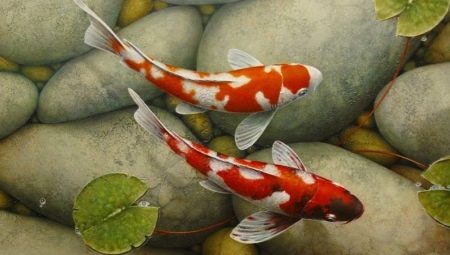Keeping aquarium fish is a fascinating and popular activity that has found its admirers among people of all ages around the world. That is why today there are a large number of breeds and species of fish that can be successfully bred in aquariums. Among the available variety, koi carp is particularly popular, notable for its appearance.
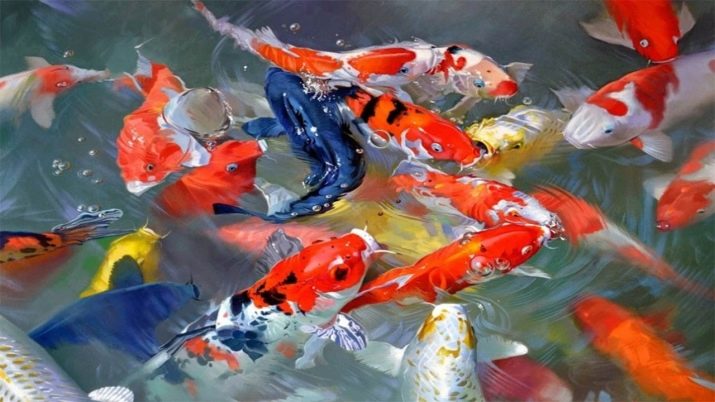
Description
Among ornamental fish grown in the aquarium, koi carp is in great demand among amateurs and professional aquarium owners. The breeding of this breed was done by Japanese breeders, with the aim of creating interesting individuals for keeping in artificial reservoirs. However, the results of their labors became interested in aquarists specializing in fish farming at home, and brocade carp began to be used in closed tanks. The difference between such a breed from relatives is the size, which differs in a smaller direction from individuals living in open waters.
Since the breed was bred artificially, special requirements are imposed on the appearance of koi carps. The proportions of fish, as well as their color, are estimated. In the wild, such a fish can not be found. The color of the representatives of the Carp family is distinguished by the saturation of shades, most often in red water and tanks you can find individuals of red color. In addition to red fish, blue, yellow and white carps are also popular.
The base color of the scales is usually complemented by rather large spots, which are distinguished by the unevenness of their shapes and sizes.There are species that have unique patterns on their bodies, concentrated on the sides and on the head.
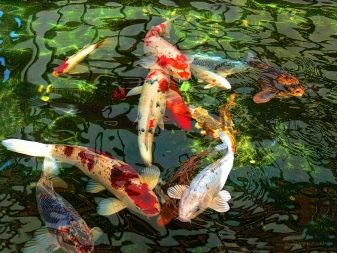
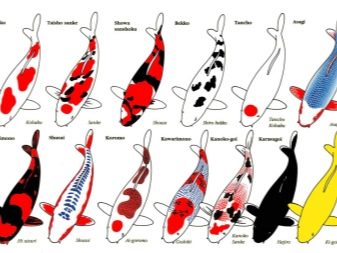
The head of the fish will be crowned with a blunt nose, which has a slight sexual dimorphism, so females from the general flock always stand out with a wider head and voluminous cheeks. The body of the fish is folded so that the maximum thickening is concentrated in the dorsal fin. Further, towards the tail it will narrow. This structural feature allows the fish to look massive even with a short length.
The smallest brocade carps will have a body length of about 20 centimeters, large individuals can reach a length of 1 meter. The fins of koi carps are distinguished by their large size and scope, so that individuals move without problems even when there is a current. The weight of the fish, as well as the size, has a large gradation; you can find brocade carp in an aquarium with a mass of about 4 kilograms, as well as relatives, whose mass will be close to 10 kilograms.
The average life expectancy of representatives of this family is 20-25 yearshowever, in large artificial ponds, fish can survive much more.
According to most breeders of such fish, it is noted that they have fairly well-developed intellectual abilities, therefore they are able to distinguish between the owner’s voice and his words. Some individuals, accustomed to their owner, even swim to the surface so that a person can stroke them.
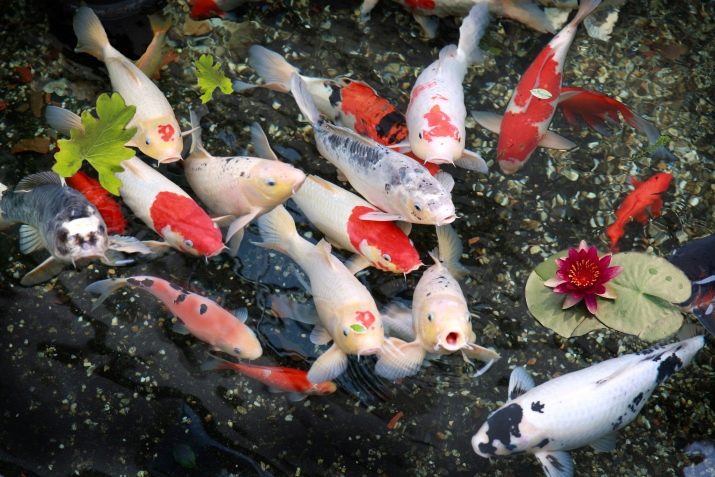
Varieties
Today, many species of fish that belong to this family can be distinguished; all of them are divided into 14 groups, where there are about 8 dozen subspecies. The most popular individuals are carps from the gosanke group, it includes such subspecies:
- tante - carp, for which a different color is acceptable, but a reddish spot near the head will be a feature;
- kohaku - white fish with red and orange spots on the back;
- taisa sanseku - a popular subspecies, the color of which should be white, as in the previous case, but the spots will be black and red;
- asagi - fish with a tint of scales on the back, close to blue, on the sides its color should be red-orange.
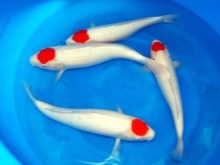

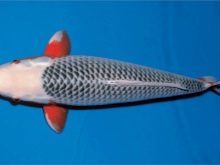
Also, the kavarimono class, in which the following breeds are present, deserves no less attention:
- Sumi Nagashi - individuals with black scales, on which there is a light border;
- hajiro - Carp of black color, which will have white specks at the ends of the fins;
- ki matsuba - yellow fish with a characteristic dark spot-net on the back;
- goshiki - carps, a feature of which is the coloring, which includes 5 different colors;
- midi-goy - a rare species of fish, bred artificially as a result of crossing two other species, is distinguished by a green color of scales;
- ochibachigure - An individual with an interesting color resembling an autumn composition of yellow-red foliage on a gray background.
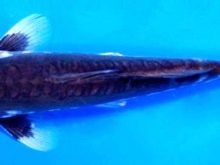

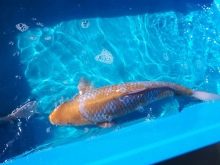
Content Rules
Decorative koi carps, as well as mirrored ones, perfectly develop in large aquariums and ponds, however, in this case, special requirements are imposed on the purity of the water and its quantity. To create the most favorable conditions for keeping fish in glass tanks, it is worth knowing that at least 4-5 liters of liquid will be required per centimeter of the length of the aquatic life. For medium-sized individuals, the use of 500-liter aquariums is allowed. Also, the following nuances deserve special attention.
- Filtration and aeration of the liquid. In order for aquarium decorative carps to feel good in closed containers, they should be installed with the most powerful filters. It would be more correct to use several devices so that they can cope with the purification of a large volume of water.
- Aeration of the aquarium. Another factor on which koi life expectancy and health will depend. Fishes need an aquatic environment that is saturated with oxygen to the maximum.That is why, in addition to the filter, it is worth placing an aerator in tanks with carp.
- Sterilization of water. Since such aquarium fish are usually kept in schools, they will need a device to carry out water disinfection. In this way, one can avoid the risk of spreading various types of viral diseases among individuals.
- Backlight. To maintain the attractive appearance of ornamental fish at the proper level, it is recommended to use high-quality and bright lighting for the tank. For home breeding metal halide lamps are usually used. In addition, aquariums with fish are recommended to be placed near sources of natural light - windows, balconies, etc. At night, lighting should be turned off.
- Water quality. The optimum temperature indicators for the breed will be + 15-30 C, with a hardness of not more than 6, acidity at the level of 7 pH. In addition, daily aquarists will need to replace a third of the fluid in the aquarium of the total volume. When the temperature drops to +10, koi can hibernate.
- Type of soil. The bottom in the aquarium should be covered with fine sand. The breed is characterized by an active study of the bottom, so all available additional decorative components should be well strengthened.
- Food. In aquariums, fish can be offered a variety of feed options. However, carps can feed on one selected species without any problems. To determine the optimal amount of food necessary for the fish, it is worth weighing it.
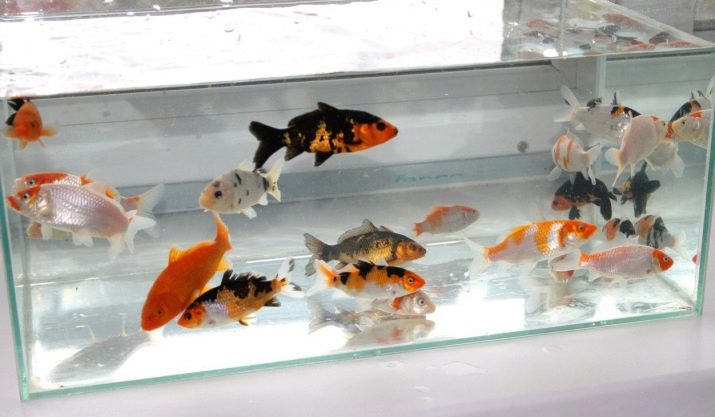
When calculating the amount of food, it is worth starting from the fact that she will need no more than 4% of the feed of her own weight per day.
The daily diet may consist of 2-3 mealshowever, food should be administered at intervals and so that koi do not swallow it all at once. It is recommended to quickly remove food residues from the aquarium.
It is important to monitor the regularity of feeding, as well as the portions used. Mistakes regarding an unnormalized koi diet can destroy an entire school of fish in just a few days.
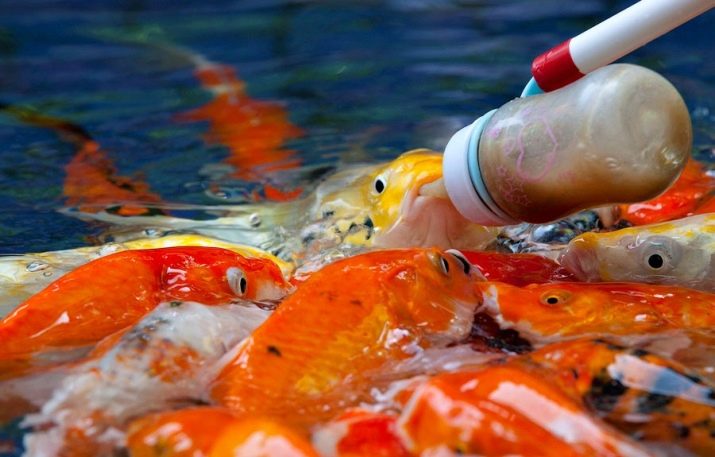
This is due to the characteristics of the digestive system of fish. Therefore, such a breed for home breeding for aquarists who have a minimum of free time, absolutely will not work. As a live feed, the use of larvae, worms, moths is allowed. In the role of an alternative that allows you to feed the carp with a balanced diet, you can consider Introduction to the diet of vegetables, boiled eggs, as well as fruits and shrimp.
Compatible with other fish
Exotic individuals stand out not only for their attractive color, but also for their calm and peaceful disposition towards other inhabitants of the aquarium. Koi perfectly coexist in the same tank or pond with the rest of the Karpov family, in addition, brocade carp very often plant together with catfish and other small decorative fish.
but the peaceful nature is not always characteristic of koi carps; during spawning, males can demonstrate a pronounced aggression towards other inhabitants of the aquarium, similar behavior also applies to females of this breed.
As for smaller fish, koi during this period can regard them as potential prey, arranging a hunt for aquatic inhabitants.

Breeding
Since fish of this breed belong to the decorative representatives bred as a result of natural selection, most of them are breeding in specialized nurseries. The complexity of this process is due to the fact that, up to a certain age, it is extremely difficult to establish the gender of the fish with accuracy. However, in general, for koi there is no need to create any specific conditions for spawning. As a rule, this process takes place in the spring months, sometimes stretching until the summer. This is due to a rise in water temperature in water bodies. Male representatives are considered ready for reproduction when their body length reaches 23-24 centimeters.
In closed tanks, to stimulate the process of laying eggs, it is recommended that with the advent of warm days, the daily rate of feeding of carps be slightly increased, focusing on the living version during this period.
Some experienced breeders specially select the best individuals from the whole pack for spawning, planting them temporarily in a separate aquarium or reservoir. Such a measure increases the chances of obtaining healthy offspring, but is not mandatory for the breed. Usually, after spawning, males are transplanted from females and eggs, as there is a chance that they will regard the fry as food. After the female lays eggs, fry should hatch after 4-7 days, during this period it is worth paying special attention to aeration of water, so that the future generation develops normally.
When koi fry hatch, they will independently attach to the walls of the tank, staying in this state for 2-3 days. This period of time is necessary for them to adapt to new conditions. As a rule, on the 4th day they will be able to independently move and swim.
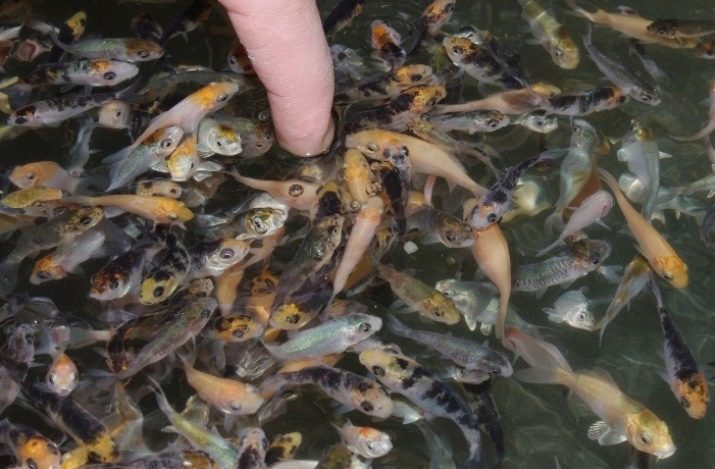
Feeding the younger generation is recommended to begin only after the fry begin to swim on their own. For these purposes, it is worth using starter feed for decorative aquarium fish.
See koi carp breeding in the next video.
